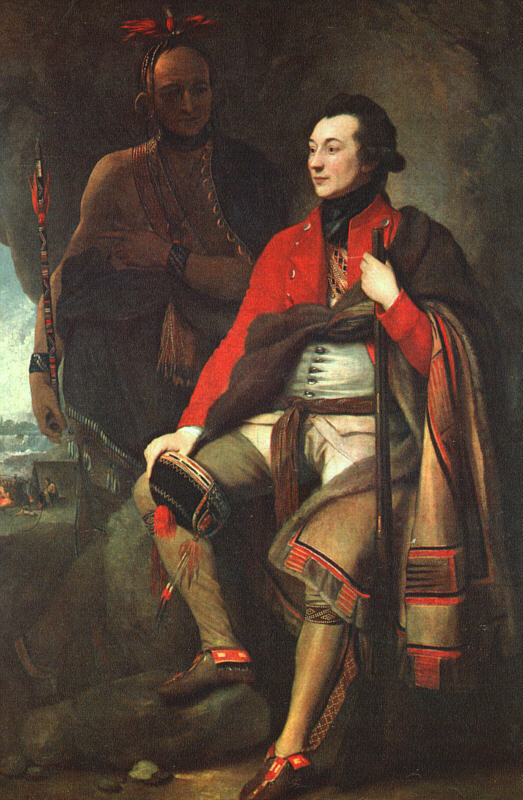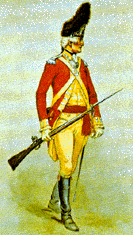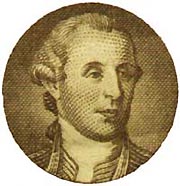 |
Colonial Soldier
![]()
Introduction: A soldier's life in the 1700's was very difficult. Since making a living during this period was difficult for most people, many young men chose to enter the army anyway. This was true for the American Colonial Militia, the British and the French Armies. Because the focus of our study are the groups and individuals in and around Albany during the period of the mid 1700's, this page will focus on the Colonial Militia with some attention paid to the British Army.
The British Army
 Much
of the British regular army was recruited from the lowest social classes.
The men who enlisted were often petty criminals, beggars, laborers, or farmers.
During times of war, British recruiting sergeants scoured the country offering
up to 20 guineas to new recruits.
(This was at a time when some people made as little as 2 guineas a year).
Most British soldiers joined for life and some would even take their families
with them if there were an open spot on the muster
role. Ultimately, it was the decision of the commanding officer of the regiment
whether private soldiers could take their families with them to war.
Much
of the British regular army was recruited from the lowest social classes.
The men who enlisted were often petty criminals, beggars, laborers, or farmers.
During times of war, British recruiting sergeants scoured the country offering
up to 20 guineas to new recruits.
(This was at a time when some people made as little as 2 guineas a year).
Most British soldiers joined for life and some would even take their families
with them if there were an open spot on the muster
role. Ultimately, it was the decision of the commanding officer of the regiment
whether private soldiers could take their families with them to war.
The "Brown Bess", a flintlock musket, was the main weapon of the British army and colonial Militias from the 1730's until the end of the American Revolution. They were used in fortified places where their long barrels and long range gave their user a considerable advantage. The "Brown Bess" was a reliable weapon, but like all weapons of the day it had certain disadvantages. In this quote, a Colonel Henry Bouquet discussed some of these in a letter to General Forbes.
| "A large part of the provincials are armed with grooved rifles and have their molds. Lead in bars will suit them better than bullets---likewise the Indiansóbut they also need fine powder FF. "I have noticed a great inconvenience in the use of cartridges for them. They do not know how to make cartridges or rather they take too much time. In the woods they seldom have time or places suitable to make them. These cartridge boxes hold only 9 charges, some 12, which is not sufficient. I think that their powder horns and pouches for carrying bullets would be much more useful, keeping the cartridge box however, to use in case of a sudden or night attack. The difficulty is in providing them." |
Colonial Militia
Introduction: Like British Army recruits, many members of the Colonial Militia came from the lower social classes, though others came from middle income families. Surviving muster rolls show that about sixty percent of the Pennsylvania recruits were laborers. The remaining forty percent were either artisans or skilled workers. These militia men had worked in the cloth, wood, or leather trades. While most of the artisans were cloth workers, some worked as coopers and carpenters. Those who enlisted from other parts of the colonies had almost the exact opposite percentage of laborers versus artisans. Many of these colonial soldiers came from property owning families. These were not men who saw the army as a way to make a living. In fact, they did not need a military income to survive. So why did they enlist? There were the usual reasons: excitement, a chance to prove themselves, and patriotism. In addition, a common reason for the enlistment of young men from landed families was to earn money to purchase land. It was land, which made a man independent from his family.
A colonial soldier usually served eight months in the militia. He was not paid until his enlistment was over, at which time he received all the money that was due to him. If he had saved his enlistment bonus, he would now have enough money to purchased between thirty and one hundred and fifty acres, more than enough for independence.
|
To learn more about the life of a colonial soldier, follow the link to one of the most famous colonial militia units of the French and Indian War, Roger's Rangers. To learn more about the early career of one of this country's great Militia Leaders, who went on to become a "Founding Father", then click on the picture of young George Washington.
|
Home Page | Assessment
| Lesson 1 | Lesson
2 | Lesson 3 | Lesson
4 | Frontier
Characters
Learning Aids | Great
Law of Peace | US Constitution | Timeline
| Works Cited
© 1 October 2001, Portland State University
